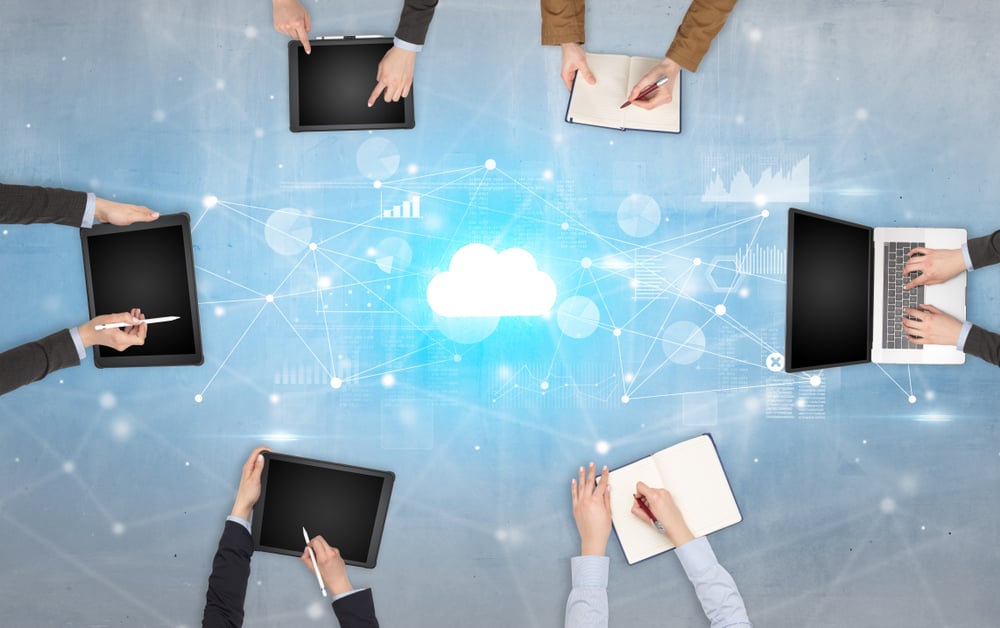Enterprise resource planning (ERP) solutions are cutting-edge technologies that can provide organizations of all sizes with a comprehensive suite of features tailored to their specific needs.
But what exactly is an ERP? How do you determine if your business needs one? What are the key components of such systems? And how can you implement one successfully?
Let's answer all these questions and more.
What is an ERP and how it helps your business succeed
WHAT IS AN ERP SYSTEM?
At its core, enterprise resource planning (ERP) is a suite of integrated applications used to manage an organization's internal and external resources. ERP systems can help automate the daily activities of a business, such as inventory management, financials, customer relations management (CRM), manufacturing, operations, supply chain management, accounting, project management, and human resources – all from one single platform.
Rather than each department relying on disparate systems with manual data entry for day-to-day operations – which can lead to costly errors in terms of accuracy and efficiency – ERP platforms enable a holistic view into how all parts of the business function at any given moment. This improved visibility gives businesses valuable insights needed for strategic decision-making, cost reduction, and improved performance.
WHY IS AN ERP IMPORTANT FOR SMALL-TO-MIDSIZE BUSINESSES (SMBS)?
In today’s digital age, companies face increasing pressure to remain competitive and gain a foothold in the market. Enterprise resource planning can be particularly beneficial for small- to medium-sized businesses (SMBs), who get access to sophisticated tools they might otherwise not have had the budget or capacity for.
Especially with the emergence of global businesses and e-commerce, SMBs need to optimize their operations and keep up with changing customer expectations.
Here are some of the benefits of implementing ERP software:
- Cost savings: ERP systems enable businesses to streamline their operations, automate business functions and reduce manual labor costs. This leads to a reduction of errors and higher accuracy of data, as well as cost reductions in administrative expenses associated with managing multiple software applications.
- Operational efficiency: ERP software provides insight into an organization's operations, making it easier for SMBs to identify areas where improvement is necessary. By mapping out core business processes and workflow activities within departments across the entire business, an enterprise resource planning system help makes operations more efficient and productive by automating tedious tasks such as data entry.
- Improved customer service: Most ERP systems help SMBs provide a better customer experience by allowing integrated access to all customer-related data in a single platform. This helps businesses respond faster and more accurately to customers’ needs, resulting in increased satisfaction and loyalty for the brand.
- Greater scalability: ERP systems can be easily customized to fit the unique needs of an SMB, making it easier for companies to scale up their business operations as it grows. This eliminates the need to replace existing software with new applications as the company expands its operations or adds new products or services.
- Automated compliance: By automating complex compliance tasks such as keeping track of financials and tax information, an ERP software system helps SMBs stay on top of regulatory requirements. This helps reduce the risk of penalties or fines due to non-compliance and keeps businesses running smoothly.
- Enhanced data security: Enterprise resource planning systems provide a secure environment for storing and managing sensitive customer information, reducing the chances of data theft or other security breaches. Businesses can also keep track of user activities better to detect potential threats or misuse of the system.
- Improved decision-making: With more reliable insights into their operations through real-time analytics tools, SMBs can make better decisions that positively impact their bottom line. By having access to up-to-date, accurate data management, leaders can gain fresh perspectives that can help them make informed decisions that drive the business forward.
- Improved collaboration: By providing a single platform for data sharing and collaboration, it is easier for teams to work together and stay on the same page. This reduces miscommunication between departments, which can lead to improved productivity and stronger team dynamics.
Overall, enterprise resource planning software offers numerous benefits for small-to-medium-sized businesses, enabling them to remain competitive in today’s digital landscape and achieve digital transformation.
7
WHAT ARE THE KEY COMPONENTS OF AN ERP SYSTEM?
ACCOUNTING AND FINANCIALS
This component of ERP software is responsible for managing accounts payable, accounts receivable, general ledger, budgeting and forecasting, cost accounting, and various other components of the financial side of a business. The Accounting and Financials component provides a real-time view of company-wide financial performance with insights on trends in customer payments and supplier invoices.
Inventory and distribution
When it comes to managing inventory and distribution processes, ERP systems provide powerful tools for tracking stock levels, setting reorder points, allocating stock to orders, and more. It also enables businesses to track their inventory in multiple warehouses and locations for more accurate stock control. This component also simplifies the process of distributing products to customers or stakeholders by tracking orders from start to finish and ensuring that all necessary information is accurately relayed.
Automating inventory-related tasks, such as stock replenishment and cycle counting, can help SMBs reduce the time spent managing their supply chain operations.
Production and MRP
Production and material resource planning (MRP) functionalities provide visibility into the entire production cycle, from raw materials to finished products. This includes tracking job progress, scheduling production runs, and managing bills of material.
This component also helps SMBs plan for inventory needs and optimize resource utilization. With real-time information on capacity levels, businesses can quickly pivot to meet customer demands with minimal effort.
Resource and project management
The resource and project management erp modules allow businesses to track resource utilization for internal and external projects. Companies can manage tasks, allocate resources, create budgets, analyze cost performance, and more. This helps optimize the use of resources while ensuring that projects are completed on time and within budget.
Sales and service
Managing customer relationships is a key component of business success, and ERP software can help streamline sales, marketing, customer service, and other related activities. Organizations can benefit from features such as order management, contact management, customer profiling, lead tracking, and management.
By utilizing an ERP system's sales and service components, companies can provide a better customer experience while increasing efficiency in their sales process. This helps improve customer loyalty and drive revenue growth.
Purchasing and operations
Purchasing and operations management capabilities provide organizations with tools to track and monitor supply chain activities. This helps ensure that orders are processed correctly, materials arrive on time, and costs stay within budget.
These components allow businesses to gain visibility into supplier performance while providing a centralized platform to manage all purchasing processes.
Reporting and analytics
With access to real-time data, organizations can quickly assess their performance and make informed decisions backed by evidence. ERP reporting and analytics allow businesses to generate graphical reports, compare different data points or trends over time, customize dashboards, and more.
By analyzing this data, companies can quickly identify areas for improvement and take proactive measures to address them before they become costly issues. Moreover, this component provides SMBs the tools to make informed decisions about their business operations and remain competitive in today’s digital landscape.
6 SIGNS YOUR BUSINESS NEEDS AN ERP SOFTWARE
When a business reaches a certain size, it can be difficult to manage with just spreadsheets and manual business processes. Businesses may notice signs that ERP software could help make operations more efficient and save time.
Here are just some of them:
- Your staff is using different software for the same tasks: When different departments or staff members use disparate software, it can lead to discrepancies and inefficiencies. It becomes difficult for the business to get a unified view of its operations. This lack of visibility stunts decision-making and can affect the bottom line.
- You need better control over inventory: Inventory control is a critical function of any business that needs to be managed accurately. Without enterprise resource planning software, it can be difficult to monitor and manage inventory levels most efficiently. This lack of visibility into stock levels can lead to overstocking or running out of items, resulting in revenue loss for the business.
- You have limited visibility into operations: Most Manual processes can make it difficult to get real-time insights into the business's day-to-day operations. Without an ERP, you may be unable to track key performance indicators or monitor the progress of projects quickly and accurately. You may also have trouble identifying areas that are causing delays or bottlenecks in production.
- You stuggle with manual processes: Manual processes are labor-intensive and time-consuming, leading to inefficiencies and delays. This can be particularly true when managing complex tasks such as budgeting, forecasting, and tracking customer accounts. Manual processes often involve paper trails that take longer to process and require more manual labor than automated systems. Additionally, they may not provide accurate data or provide easy visibility into processes. Moreover, manual data entry and processes are susceptible to errors and inaccuracies.
- Your customer data is scattered across different systems: Having customer data scattered across different systems can lead to inaccurate information, making it difficult to get a comprehensive view of the customer. This can lead to lost opportunities and delays in processing orders and providing timely service. Additionally, it may be difficult to identify trends or gain insights into customer behavior when data is not stored in one place.
- You want to keep up with the competition: Legging behind the competition in today's digital age can be costly. Businesses that rely on manual processes or multiple software for the same tasks may not be able to keep up with their competitors who use an ERP system. The ability to access real-time data and insights, improve customer service, manage operations more efficiently, and automate tasks are all benefits of using business management software.
If any of these signs sound familiar, it’s time to consider investing in an ERP system. Implementing the right system for your business can help you stay ahead of the competition and save time, money, and resources.
Contact us today to see how we can help you make the transition easier.
INDUSTRIES THAT BENEFIT FROM AN ERP SYSTEM
MANUFACTURING
For manufacturing companies, ERP systems can help streamline operations by helping with inventory management, forecasting needs, and managing the plant's assets. They also integrate easily with components like supply chain management and logistics solutions to better track raw materials and finished products as they move through the production process.
RETAIL
Retailers can benefit greatly from an ERP system, as it provides them with an integrated view of their business. This means that they can easily track customer orders and inventory levels and manage pricing and promotions more efficiently. Additionally, an ERP system can help retailers better understand consumer trends and behave proactively to remain competitive in the market.
FINANCIAL SERVICES
ERP systems are particularly helpful for financial services firms that need to keep detailed records of all transactions. An ERP software ensures accuracy by automating data entry into the system so that all financial information is up-to-date and auditable if needed. Additionally, this technology helps streamline processes such as billing or invoicing, reducing the time needed to process these tasks significantly.
WHOLESALE AND DISTRIBUTION
Wholesalers and distributors rely heavily on managing complex supply chains. An ERP system can provide transparency into these processes, allowing for improved performance management across the board. This leads to greater efficiency with fewer delays or issues due to incorrect data entry or poor communication between departments. Additionally, ERP software allows wholesalers and distributors to easily track inventory levels and order new materials as needed from their suppliers quickly and accurately.
FOOD AND BEVERAGE
The food and beverage industry is an incredibly competitive sector and one where margins can be slim. An ERP software can provide detailed insights into costs and processes to help identify areas for improvement. Additionally, it streamlines the flow of goods from suppliers to customers with more accurate ordering and tracking capabilities. With this increased visibility, food and beverage companies can better manage their operations while maximizing profits.
AGRICULTURE
Agricultural businesses often have complex operations spanning multiple sites and a large number of employees. An ERP system can allow them to manage all of these processes from a single platform, allowing for improved efficiency and better management of resources between different sites. It also helps agricultural businesses monitor production levels to be prepared for seasonal changes in demand and ensure that products are delivered on time and within budget.
HOW DOES AN ERP SYSTEM WORK?
Enterprise Resource Planning (ERP) systems are designed to manage a wide range of activities within an organization, from financials and human resources to supply chain management and beyond. This multi-functional approach helps organizations streamline processes, reduce costs, and create new opportunities for growth. At its core, ERP integrates data from different parts of the business into a single system so employees can access accurate information quickly and easily.
The real value of ERP software lies in how the integrated data can help organizations make strategic decisions, improve operational efficiency, and reduce costs. As you can see, an ERP system is more than just a tool; It allows for greater visibility into key performance metrics such as cash flow, inventory levels, customer relationships, and profitability.
For example, suppose a salesperson needs to know the inventory levels of a product. In that case, they can look it up in the ERP software instead of calling the warehouse directly or accessing an offline Excel file. This saves time and reduces the risk of errors that can occur when working with multiple data sources. The inventory was updated in the ERP system once the warehouse registered a transaction, such as an incoming shipment.
That said, there is more than one way to implement ERP software to meet the specific needs of your business. Different industries and businesses may require different ERP components, and assessing your specific needs is important before you begin the implementation process.
For example, some businesses would like to use RFID or handheld scanners to track inventory in their warehouses, while others may need e-commerce capabilities to manage sales online or integrate customer-facing systems with their ERP.
Understanding the scope of your project before implementing ERP software is essential for success.
DIFFERENT ERP DEPLOYMENT OPTIONS
Choosing the deployment option that best suits your business is essential for long-term success. For example, companies with large amounts of data or a complex supply chain may benefit from an on-premise ERP system. On the other hand, companies that need to be agile and able to scale their operations quickly may want to opt for a cloud ERP solution. This is just one example, so assessing your business needs is important before making a decision.

ON-PREMISE ERP
The most common option is an on-premise system, which is software that is installed and run from the company’s own servers. This type of setup requires upfront costs for hardware and additional staff to manage the system.

Cloud ERP
A cloud ERP allows for remote access and the ability to scale up or down according to business needs. Cloud ERP solutions are typically more cost-effective than on-premise systems, as they require less upfront investment. They also allow for faster deployment times and easier scalability.

HYBRID ERP
A hybrid ERP model is also available, which combines the strengths of on-premise and cloud ERP solutions. This type of deployment allows companies to maintain certain aspects of their ERP system internally while taking advantage of the flexibility and scalability that cloud solutions offer.

WHAT ARE THE REAL COSTS OF AN ERP SYSTEM?
An ERP software can be a substantial investment for any company, so it is important to understand the true costs associated with implementing one.
While the exact cost will vary depending on factors such as complexity and customization, several major expenses should be taken into consideration before committing to a particular solution.
- License fees: The first major cost associated with ERP software is the license fees. These can vary greatly depending on the type of software and features required. Additionally, many vendors offer annual maintenance fees to keep the software up-to-date with industry standards. In a cloud ERP, the payment is usually on a subscription basis.
- Maintenance cost: In addition to the initial license fee, ongoing maintenance costs are associated with an ERP system. This includes paying for any upgrades and additional features that may be required and the cost of hiring staff to manage the system.
- Training: Training staff to use the ERP technology is also essential for successful implementation. This can include both on-site and online training, which can be costly depending on the size of your company.
- Data migration: Data migration is a critical factor in the success of any ERP system. It involves transferring all existing data from one system to another, which can be both time-consuming and costly.
There are more costs to consider when implementing an ERP system. These include hardware costs, consulting fees, and the cost of customization for specific business needs. These can add up quickly, resulting in a major expense for the company. It’s important to understand all of the associated costs before committing to an ERP software – and not just focus on upfront license fees.
Fortunately, the cost of ERP systems has come down in recent years thanks to advances in cloud computing and software-as-a-service models. This means that companies can now implement ERP software without breaking the bank. Additionally, most vendors offer financing options or other payment plans to make it easier for businesses to get the most out of their investments.
With proper planning and careful consideration of all costs involved, companies can ensure that ERP software is the right choice for their business – and get the maximum benefit from it without blowing their budget.
CHOOSING THE PERFECT ERP FOR YOUR BUSINESS
Choosing the perfect ERP solution for a business can be a daunting task, as there are many factors to consider. The right system should meet the organization's goals and objectives while considering budget constraints and existing technology infrastructure.
- Assess your needs: The first step in selecting an ERP system is to assess the organization's needs. This includes taking an in-depth look at the current business processes, exploring any challenges that may arise when transitioning to a new system, and determining which features are absolutely necessary.
- Research potential vendors: Once the requirements have been determined, it’s time to research potential implementation partners. Vendors should be evaluated based on their track record for customer service, implementation experience, and pricing structure. Reviews from other customers can also provide valuable information about a vendor's performance and reliability.
- Consider the total cost of ownership (TCO): The total cost of ownership (TCO) includes factors such as software licensing fees, maintenance costs, training expenses, and any other costs associated with the implementation and ongoing use of the system. It is important to remember that these costs can vary greatly depending on the specific solution chosen.
- Evaluate vendor support: When evaluating potential vendors, it is also important to consider their level of customer support. Many companies provide a range of services designed to help customers make the most out of their ERP systems, including personalized training sessions and regular updates to keep up with changing technology trends. Having access to reliable customer service can make a huge difference when implementing or troubleshooting an ERP system.
Ultimately, the right ERP solution should be tailored to meet the unique needs of each business. By taking the time to thoroughly assess their goals and budget constraints, businesses can ensure they make an informed decision and get the most out of their investment. This knowledge will help them make more informed decisions, leading to successful implementations that result in long-term success.
HOW LONG DOES IT TAKE TO IMPLEMENT AN ERP?
When considering implementing an ERP system, one of the most important questions to ask is: how long will it take? The duration of your ERP implementation depends on various factors, such as the scope of your project, complexity, and size.
Generally speaking, a typical ERP implementation can take anywhere from several months to over a year, and even more than this for large businesses. This timeline includes the time it takes to customize and configure the system, train employees, and migrate existing data. It is important to plan for adequate time for all of these steps to be completed successfully. Of course, there is no one-size-fits-all approach to the timeline, and businesses should have reasonable expectations as they plan out their ERP implementation.
Your team's quality and dedication to the project further impact the amount of time taken to roll out ERP software. Dedicated, experienced resources will be able to identify risks quickly to minimize the timeline's impact. Having a team dedicated solely to the implementation will also help keep costs down, as having multiple people working on overlapping tasks can cause delays and overspending.
For businesses looking for faster deployment times, some ERP vendors now offer software-as-a-service (SaaS) solutions with preconfigured components or basic building blocks that can be customized according to specific business needs. These cloud-based systems come with more limited customization options than traditional ERP solutions but can be deployed quickly due to their pre-packaged nature.
Finally, some vendors offer “accelerated implementation” services designed to shorten the time it takes for ERP implementations. By reducing the need for customizations and implementation consulting, these accelerated processes allow businesses to get up and running with a new system in as little as 4-6 weeks.
Overall, the exact timescales of an ERP implementation are impossible to predict due to the many variables involved. Businesses should plan carefully and ensure they understand how long it might take before making any commitments regarding timeline or budget. With careful planning, dedication from the project team, and a clear scope of what is needed, businesses should be able to deploy their ERP system in a timely and cost-effective manner.
CHALLENGES WHEN IMPLEMENTING AN ERP SYSTEM
Implementing an ERP software solution is no small feat. It requires deep planning and resources to ensure a successful project. Many businesses may struggle to transition from manual to automated processes due to several challenges that systemic change can bring.
These are some of the main challenges your business might face when implementing an ERP system:
- Data migration: This is often one of the biggest obstacles for SMBs wanting to switch over their systems and processes. Collecting all relevant data points must be migrated into the new system is important. The complexity of this process largely depends on the scale and scope of your business operations and the type of ERP software you employ.
- Budget: ERP systems can be expensive and, if not planned correctly, could result in additional costs or delays due to having to adjust budgets. It is highly recommended that SMBs understand their budget before investing in a system, taking into account its implementation fees, maintenance costs, and ongoing training expenses.
- Change management: For employees accustomed to manual processes and data entry, making such a drastic change all at once may take some getting used to. For any implementation plan to be successful, everyone affected by the new ERP must be on board with the changes. This includes considering each stakeholder’s role in the project and ensuring sufficient training to help them understand how the system works.
- Compatibility: ERP systems require a certain level of compatibility with existing hardware and software. If they cannot integrate properly, it can lead to costly delays or project cancellation altogether. To ensure a successful implementation, businesses should invest in an experienced IT team that can assess the current technology infrastructure and determine what changes need to be made.
Ultimately, when implementing an ERP system, SMBs need to factor in strategic planning as well as financial investments into their budgeting process. It is also important for decision-makers within organizations to carefully consider any potential challenges that could arise throughout the process, such as data migration, budget, change management, and compatibility.
By doing this, SMBs can anticipate any issues down the line and ensure a successful ERP implementation for their business.
BEST PRACTICES FOR ERP IMPLEMENTATION
To successfully implement an ERP system, your organization must have a clear understanding of the challenges that may arise during implementation and what resources are necessary to overcome those challenges.
- Understand your needs: For SMBs considering ERP software for the first time, assessing the company’s needs and goals in detail is important before deciding which solution makes sense. This can be done by engaging a qualified service provider who can advise on key elements such as ERP integration, user training, data migration, customizations (if relevant), etc. Having such conversations upfront will ensure that resources are allocated effectively and timelines are realistic from the outset.
- Choose the right team: Your ERP implementation project will require a combination of technical and functional expertise from different business areas such as finance, operations, IT, etc. It is important that these individuals are identified early in the process and that each person understands their own role in the project. Working together as a team will help ensure that any potential challenges are addressed quickly and efficiently.
- Create a timeline and timeline milestones: Having an accurate timeline for your ERP implementation can help you quickly identify any bottlenecks or deviations from the plan. It is also important to establish deadlines for key milestones so stakeholders can review progress regularly and make necessary adjustments.
- Conducting testing and quality assurance: Testing the ERP software before go-live is essential to ensure that all technical and functional aspects work as intended. This includes testing data migration, customizations (if any), user interfaces, and other application integrations. Quality assurance should also be conducted on a regular basis to identify any issues before they become bigger problems.
- Ensure adequate training: As mentioned earlier, switching from manual to automated processes may take some time for employees. Any ERP implementation must include sufficient training and onboarding activities for everyone affected by the system so they can easily transition into new roles.
- Continuous improvement and optimization: Once the new ERP system is up and running, it is important to ensure that processes are monitored regularly to identify any areas for improvement. This may include changing user interfaces, customizations, integrations, etc. Continuous optimization of the system will help ensure that SMBs get the most out of their ERP solution in terms of cost savings and increased efficiency.
- Communicate regularly with stakeholders: Throughout the project, all stakeholders must remain informed of the progress and any deviations from the plan. Regular communication ensures that everyone involved in the project has a clear picture of its status and can make timely decisions when necessary.
- Be prepared for unexpected challenges: Finally, implementing an ERP can be complex, and there is always potential for unanticipated challenges to arise during such a process. Being aware of this and taking the necessary measures to prepare for such events is essential to ensure a successful implementation.
THE FUTURE OF ERP SYSTEMS
The enterprise resource planning (ERP) software industry is undergoing a major transformation. Global market demand for ERP systems is increasing as more businesses, from small and medium-sized enterprises to large corporations, recognize the benefits associated with this technology.
Advances in cloud computing, artificial intelligence (AI), natural language processing, robotic process automation (RPA), and other technologies enable companies to benefit from convergence in their business operations by leveraging ERP solutions. At the same time, organizations must manage growing complexity to remain competitive and compliant with industry regulations.
The future of ERP lies at the intersection of these two trends: increased complexity and advanced technology. Here’s a look at the key ERP trends to watch in the ERP space:
- Cloud-based ERP solutions: The cloud is revolutionizing how businesses deploy and access ERP systems, allowing them to take advantage of scalability, cost savings, increased efficiency, and other benefits associated with cloud computing. As more businesses migrate their IT infrastructure to the cloud, ERP solutions designed for this type of environment will become increasingly popular.
- Big data analytics and artificial intelligence (AI): AI enables companies to use data-driven insights for a whole new level of operational agility and improved decision-making. By leveraging big data analytics, organizations can get real-time visibility into business operations, identify areas of improvement and optimize their processes accordingly. AI-driven ERP systems are valuable tools for businesses looking to optimize their operations.
- Emphasis on cybersecurity: ERP vendors are investing heavily in security measures to ensure that their solutions meet the highest data protection and privacy standards. This includes using encryption technology, monitoring user access, and instituting rigorous authentication protocols. As businesses become increasingly dependent on cloud-based ERP systems, cybersecurity will continue to be a top priority for vendors.
- Internet of Things (IoT) ERP integration: The emergence of IoT-enabled devices is allowing businesses to collect and analyze data from sources that were not previously possible. For example, sensors can be used to track the performance of machinery and equipment, allowing companies to identify potential problems before they become serious. ERP solutions that can integrate with IoT devices will become increasingly important for organizations looking to capitalize on this technology.
As technology continues to evolve, businesses will need robust ERP solutions capable of adapting quickly to changing market conditions. The future of enterprise resource planning lies at the intersection of advanced technological capabilities and increased complexity—and companies that can successfully leverage these trends will be well-positioned to succeed in the years ahead.
FREQUENTLY ASKED QUESTIONS
- WHAT IS AN EXAMPLE OF AN ERP?
An example of an ERP is SAP Business One, which provides modules for financial management, supply chain planning and execution, customer relationship management, sales and distribution, and more. - WHAT ARE THE 3 COMMON TYPES OF ERP?
The three common types of ERP are on-premise, cloud-based, and hybrid. On-premise ERP systems are installed and managed in-house, while cloud-based ERP systems are hosted on remote servers. Hybrid ERP systems combine both on-premise and cloud-based elements. - WHAT DOES ERP STAND FOR IN SOFTWARE?
ERP stands for enterprise resource planning. It is a software suite designed to enable organizations to manage their business processes more efficiently by integrating data across multiple departments. - IS SAP AN ERP SOLUTION?
Yes, SAP is one of the most popular ERP solutions available. It offers finance, supply chain management, customer relationship management, sales and distribution, human resources, and more modules. - IS EXCEL AN ERP SYSTEM?
No, Excel is not an ERP system. It is a spreadsheet software designed for storing and analyzing data. While it can be integrated with some ERP solutions, it is not a full-fledged enterprise resource planning platform. - WHAT IS CRM VS. ERP?
CRM is customer relationship management software, while ERP is enterprise resource planning software. CRM allows companies to manage their interactions with customers and prospects, while ERP enables them to manage their business processes more efficiently. - WHO USES AN ERP?
ERP is used by businesses of all sizes, from small companies to large enterprises. It is often used in manufacturing, retail, healthcare, finance, and hospitality industries. - WHY WOULD A COMPANY CHOOSE TO IMPLEMENT AN ERP?
Companies choose to implement an ERP for various reasons, including increased efficiency and productivity, better customer service, improved data accuracy, greater visibility into business performance, and reduced costs. ERP can also help businesses gain a competitive edge by allowing them to quickly adapt to changes in their industry or market. - WHAT IS THE BEST ERP SYSTEM?
The best ERP for your business will depend on various factors, such as budget, industry type, number of users, and desired features. Some popular ERP solutions include SAP Business One, Microsoft Dynamics 365, Oracle E-Business Suite, and Infor CloudSuite.
MORE ON ERP SYSTEMS
DO YOU WANT TO KNOW MORE?
Request your personalized demo and find out how our ERP solutions can help support your business growth.





